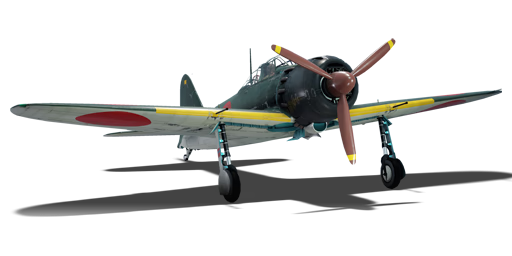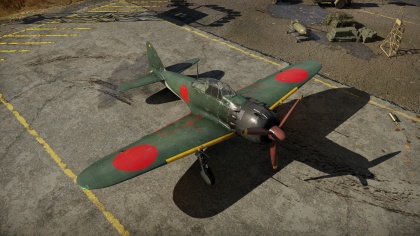Difference between revisions of "A6M5 Ko"
Inceptor57 (talk | contribs) (Readded section description as comments) |
Inceptor57 (talk | contribs) m (→External links) |
||
| Line 252: | Line 252: | ||
{{Japan fighters}} | {{Japan fighters}} | ||
| + | {{Japan premium aircraft}} | ||
Revision as of 16:36, 3 April 2019
Contents
| This page is about the Japanese gift fighter A6M5 Ko. For other uses, see A6M (Family). |
Description
The A6M5 Ko Reisen is a rank IV gift Japanese fighter
with a battle rating of 5.0 (AB), 5.3 (RB), and 4.7 (SB). This fighter has been in the game since the start of the Open Beta Test prior to Update 1.27.
General info
| Characteristics | |||||||
|---|---|---|---|---|---|---|---|
| Stock | |||||||
| Max Speed (km/h at ?,000 m) |
Max altitude (meters) |
Turn time (seconds) |
Rate of climb (meters/second) |
Take-off run (meters) | |||
| AB | RB | AB | RB | AB | RB | ||
| ? | ? | 10900 | ??.? | ??.? | ??.? | ??.? | ??? |
| Upgraded | |||||||
| Max Speed (km/h at 6,000 m) |
Max altitude (meters) | Turn time (seconds) | Rate of climb (meters/second) |
Take-off run (meters) | |||
| AB | RB | AB | RB | AB | RB | ||
| ? | 540 | 10900 | ??.? | 16.0 | ??.? | 16.9 | 190 |
Details
| Features | ||||
|---|---|---|---|---|
| Combat flap | Take-off flap | Landing flap | Air brakes | Arrestor gear |
| X | X | X | X | X |
| Limits | ||||
|---|---|---|---|---|
| Wing-break speed (km/h) |
Gear limit (km/h) |
Combat flap (km/h) |
Max Static G | |
| + | - | |||
| 0 | 300 | ??? | ~?? | ~? |
| Optimal velocities | |||
|---|---|---|---|
| Ailerons (km/h) |
Rudder (km/h) |
Elevators (km/h) |
Radiator (km/h) |
| < ??? | < ??? | < ??? | > ??? |
| Compressor (RB/SB) | ||
|---|---|---|
| Setting 1 | ||
| Optimal altitude | 100% Engine power | WEP Engine power |
| ?,??? m | ??? hp | ?,??? hp |
Survivability and armour
Examine the survivability of the aircraft. Note how vulnerable the structure is and how secure the pilot is, whether the fuel tanks are armoured. Describe the armour, if there is any, also mention the vulnerability of other critical aircraft systems.
Armaments
Offensive armament
Usage in battles
Describe the tactics of playing in an aircraft, the features of using vehicles in a team and advice on tactics. Refrain from creating a "guide" - do not impose a single point of view, but give the reader food for thought. Examine the most dangerous enemies and give recommendations on fighting them. If necessary, note the specifics of the game in different modes (AB, RB, SB).
Manual Engine Control
| MEC elements | ||||||
|---|---|---|---|---|---|---|
| Mixer | Pitch | Radiator | Supercharger | Turbocharger | ||
| Oil | Water | Type | ||||
| Controllable | Not controllable | Not controllable | Not controllable | Separate | Not ontrollable | Not controllable |
Modules
| Tier | Flight performance | Survivability | Weaponry | ||
|---|---|---|---|---|---|
| I | Fuselage Repair | Radiator | |||
| II | Compressor | Airframe | |||
| III | Wings Repair | Engine | |||
| IV | Engine Injection | Cover | |||
Pros and cons
Summarize and briefly evaluate the vehicle in terms of its characteristics and combat effectiveness. Mark its pros and cons in the bulleted list. Try not to use more than 6 points for each of the characteristics. Avoid using categorical definitions such as "bad", "good" and the like - they have a substitution in the form of softer "inadequate", "effective".
Pros:
Cons:
History
Ingame Description
Mitsubishi Type 0 Model 52 ""Ko"" (A6M5 Model 52a, reporting names: Zeke/Hamp/Zero) single-engine carrier-based fighter
In the middle of 1942, the Allies in the Pacific Ocean Theatre took the offensive, while the Japanese were more and more often on the defensive. In 1943, new types of high-speed fighters entered service with the USAAF and the USNAF, and they outperformed the Zeros in many respects. Low survivability, the main disadvantage of the Japanese aircraft, was made clear in the fierce air duels between the planes. The fighter's flight characteristics also required some improvement, and Mitsubishi Heavy Industries designers began to upgrade the A6M again in August 1943.
The Zero received a smaller-area wing (with a span of only 11 m) with rounded tips. The wing folding mechanism was removed. To increase the plane's allowable diving speed, its wing surface skin was reinforced.
Since more powerful engines were not yet available, the designers had to make the most of a Nakajima Sakae 21 engine. Every pair of cylinders was given an individual exhaust pipe instead of a common heavy exhaust manifold. This added exhaust gas thrust to the propeller thrust, which resulted in a higher aircraft speed. The fuselage skin had to be reinforced with steel sheets in the area of the pipes, since the hot exhaust gases quickly burned through thin duralumin.
The new version of the aircraft was designated Model 52 (A6M5 Model 52). The plane became slightly heavier, but its maximum speed at a height of 6,000 m reached 565 km/h. This was the speed limit for the Zero, since all further modifications made to the machine only increased its weight and, consequently, reduced its maximum speed.
The next stage in upgrading the Zero was the Model 52 ""Kou"" (A6M5a Model 52a). This improvement significantly reinforced the plane's armament by replacing the wing-mounted Type 99-2 Model 3 drum-fed cannons (with 100 rounds each) with Type 99-2 Model 4 belt-fed cannons (with 125 rounds). This added 25 rounds per cannon and slightly improved the plane's rate of fire. Now the fighter's armament consisted of two synchronous 7.7 mm Type 97 machine guns with 500 rounds each plus two wing-mounted 20 mm Type 99-2 Model 4 cannons with 125 rounds each.
The A6M5 Ko fighter could carry bombs: two 60 kg (132 lb) bombs suspended under the wing and one weighing 250 kg (551 kb) under the fuselage.
In addition, the A6M5 Ko's wing structure was reinforced yet again, which resulted in a maximum allowable diving speed of 740 km/h. However, this was still inferior to the diving speed of the American F4U fighter.
Mass production of the A6M5 Ko variant began in March 1944. Mitsubishi Heavy Industries manufactured 391 machines. An additional unknown quantity of this variant was built by Nakajima Aircraft.
Media
Skin and Camouflages for the A6M5 Ko in Warthunder Live.
See also
Links to the articles on the War Thunder Wiki that you think will be useful for the reader, for example:
- reference to the series of the aircraft;
- links to approximate analogues of other nations and research trees.
External links
[Wikipedia] A6M5 Type 0 Model 52
| Japan fighters | |
|---|---|
| Navy | |
| Carrier-based fighter | |
| A5M | A5M4 · Hagiri's A5M4 |
| A6M | A6M2 mod. 11 · A6M2 · A6M3 · A6M3 mod. 22 · A6M3 mod. 22Ko · A6M5 · A6M5 Ko · A6M5 otsu · A6M5 Hei · A6M6c |
| A7He | A7He1* |
| A7M | A7M1 (NK9H) · A7M2 |
| Land-based Fighter | |
| J2M | J2M2 · J2M3 · J2M4 Kai · J2M5 · J2M5 (30 mm) |
| J6K | J6K1 |
| J7W | J7W1 |
| N1K-J | N1K1-Ja · N1K2-J · N1K2-Ja |
| Fighter seaplane | |
| N1K | N1K1 |
| A6M-N | A6M2-N |
| Army | |
| Ki-10 | Ki-10-I · Ki-10-I C · Ki-10-II · Ki-10-II C |
| Ki-27 | Ki-27 otsu · Ki-27 otsu Tachiarai |
| Ki-43 | Ki-43-I · Ki-43-II · Ki-43-III otsu |
| Ki-44 | Ki-44-I · Ki-44-I 34 · Ki-44-II otsu · Ki-44-II hei |
| Ki-61 | Ki-61-I ko · Ki-61-I otsu · Ki-61-I hei · Tada's Ki-61-I hei · Ki-61-I tei · Ki-61-II Otsu Kai |
| Ki-84 | Ki-84 ko · Ki-84 otsu · Ki-84 hei |
| Ki-87 | Ki-87 |
| Ki-94 | Ki-94-II |
| Ki-100 | Ki-100 · Ki-100-II |
| Other countries | ▅F4U-1A · ▅P-51C-11-NT · ▅Bf 109 E-7 · ▅Fw 190 A-5 |
| *Imported designation of the He 112 (A6M was in development - A7M would take A7 designation after the cancelation of the A7He) | |
| Japan premium aircraft | |
|---|---|
| Fighters | Hagiri's A5M4 · A7He1 · Ki-27 otsu Tachiarai |
| Ki-44-II otsu · ▅Bf 109 E-7 · ▅F4U-1A · Ki-100-II · Ki-44-I 34 | |
| ▅Fw 190 A-5 · A7M1 (NK9H) · Tada's Ki-61-I hei · ▅P-51C-11-NT | |
| J2M4 Kai · A6M5 Ko · A6M6c · J2M5 · Ki-87 · J6K1 | |
| Twin-engine fighters | Ki-96 |
| Jet fighters | F-86F-40 JASDF▅ · T-2 Early · F-4EJ ADTW |
| Strike aircraft | ▄AV-8S |
| Bombers | Ki-21-I hei · Ki-48-II otsu · H8K3 · B7A2 (Homare 23) · ▅B-17E |





